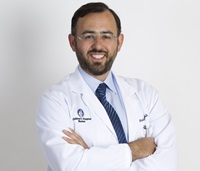 In the clinical world, Boston Children’s Hospital surgeon Khashayar Vakili, MD, specializes in liver, kidney and intestinal transplant surgeries, while in the lab he is doing work which, for some patients, could eliminate the need for a transplant surgeon altogether and for others, could lead to better outcomes for those with liver tumors.
In the clinical world, Boston Children’s Hospital surgeon Khashayar Vakili, MD, specializes in liver, kidney and intestinal transplant surgeries, while in the lab he is doing work which, for some patients, could eliminate the need for a transplant surgeon altogether and for others, could lead to better outcomes for those with liver tumors.
Vakili has been working at Boston Children’s for six years. During his transplant surgery fellowship, he spent several months learning about pediatric liver transplantation from Heung Bae Kim, MD, director of the Boston Children’s Pediatric Transplant Center, which prompted his interest in the field.
“When the opportunity to join the transplant team presented itself, I did not hesitate to accept,” he says.
Avoiding liver transplant for patients with metabolic disorders
One of Vakili’s most promising research projects involves autologous hepatocyte transplantation—not transplanting the liver but just the liver cells, and doing so using the cells from the patient, avoiding the need for immunosuppression. Along with Fernando Camargo, PhD, of the Stem Cell Program at Boston Children’s Hospital, Vakili is looking for ways to correct the enzyme defect in patients with metabolic disorders. Although the project is in its early stages, Vakili says the potential implications are promising.
“If we can correct the cells, expand them and give patients back their own cells, we can remove the risk of rejection.”
Patients with metabolic disorders make up 13 percent of pediatric liver transplants across the nation. These inherited disorders occur when the metabolism is disrupted by an enzyme deficiency. The loss of the enzyme can cause an increase in waste products such as ammonia, which can build up in the blood and be toxic to the brain. If children are no longer able to be managed medically and through diet, they get referred for transplantation.
Once the liver is transplanted, the missing enzyme is introduced and the child no longer needs to be on a special diet; there is no longer a risk of neurological side effects. But this also means the child must undergo a major surgery and take daily immunosuppression.
“The problem with hepatocyte transplantation is that these cells still come from donor livers, and the body still wants to reject them,” Vakili says. “It works transiently for a few months and then the effects go away, and it still requires immunosuppression. So you can bypass the surgery, but in a few months the child would need another donor.”
Testing the theory
 Vakili and Carmargo wanted to find out if a patient’s own hepatocytes could be corrected and transplanted back into the liver.
Vakili and Carmargo wanted to find out if a patient’s own hepatocytes could be corrected and transplanted back into the liver.
“I gave him cells from a patient, and he’s been working on isolating the stem cells from the liver and correcting the genetic mutation.”
Over the past few months, they have been able to correct the gene and expand those cells in a petri dish, but now they must wait to see how the cells will function once they have been transplanted in mice.
“Once you fix the gene cells in a dish, you have to make sure these cells will actually become liver cells in the right environment.”
If the mouse study is a success, it raises the possibility of bypassing transplant and immunosuppression, but it is not without risk. As with any genetic modification, there is always an increased risk of cancer. But Vakili says, with better molecular technology, over time, the risks of genetic modification might become less than risks of transplantation.
“The fact they were able to correct the gene is promising. I am looking forward to seeing what happens to the mice and seeing if these cells will become liver cells. Hopefully, in the next few months we will see just how promising this is.”
Battling liver tumors
Another area of research on which Vakili is focused is finding a mechanism to decrease the growth of hepatocellular carcinoma. Transplant and surgery alone are usually ineffective for hepatocellular carcinoma because of the aggressive nature of the disease and the fact that there is no chemotherapy that actually works against the tumor.
“Once a liver cell becomes a tumor cell it doesn’t do the normal things a liver cell does,” says Vakili. “All it wants to do is divide and invade blood vessels and go elsewhere. So we look at the tumor cell signaling patterns and try to figure out the machinery of the cell that is different from normal, which cells we need to target to slow things down, and at what point we can interfere to stop its growth.”
Vakili’s study of liver tumors is important to him because on a number of occasions he has seen children present with liver tumors undergo advanced surgical resection or transplantation. But due to the biology of the tumor, it recurs. By studying individual patient tumors, he hopes to gain a greater understanding of the tumor’s biology with the goal of finding new therapeutic targets.
